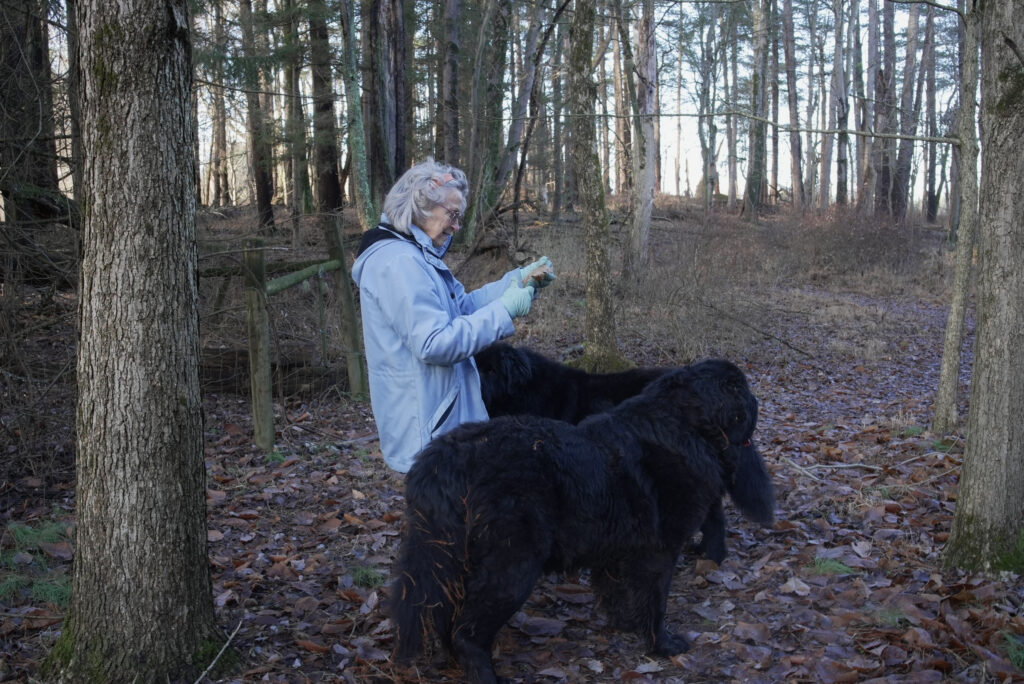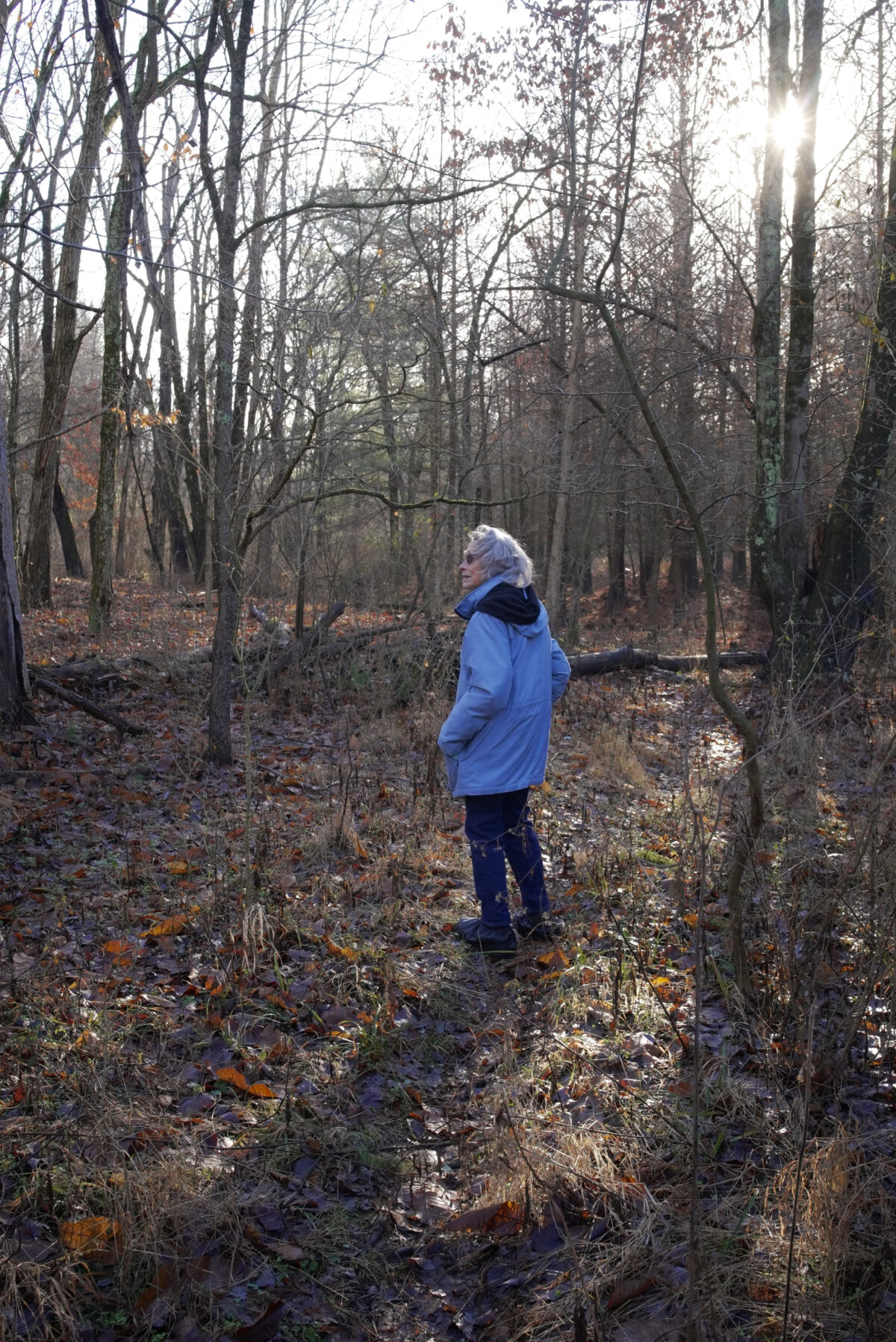Joan Krone, an 83-year-old retired Denison University professor of computer science, doesn’t have outdoor shoes: She has indoor shoe-covers.
She strolls through her nine-acre property on Milner Road four times a day, always with her two Newfoundland dogs Simon and Samson, both big enough to make anyone weary. The thin trails and woods seemed to stretch on forever. Groves of trees — hundreds of cypress, hickory nut, chestnut, black alders, river birch and walnut — sit leafless for winter, bathed in the golden light of a morning sun.

The frozen ground crunched beneath the trio’s feet, Simon and Samson staying close underfoot. It requires a nimbleness to trek across Krone’s property.
“My primary care doctor said that walking in the woods is better than walking on flat surfaces, because you have to keep your balance,” Krone said. “It keeps you from aging too fast.”
Krone moved to her nine acres of land near Granville’s historic Bryn Du Mansion nearly 30 years ago. Since then, she has been working to increase the biodiversity of her land, planting hundreds of trees. She stopped in the middle of a wetland populated by a cypress grove. The roots presented themselves as an infinite game of “Whack-a-mole” as they burst out of the ground in every direction.
And now, that grove — and the surrounding nine acres — is protected from development for years to come with the help of the Licking Land Trust.

The Licking Land Trust, a nonprofit organization “dedicated to the protection of green space and natural landscapes in and around Licking County” according to its website, works with local landowners to protect land from future development.
Currently, the organization protects nearly 2,000 acres across the county through conservation and agricultural easements: legal agreements that allow landowners to retain ownership while permanently limiting certain types of development
“With new developments like the technology chip facility and increasing demand for housing, there’s a real possibility of changing the nature of the area forever,” Krone said in an October news release. “Maintaining native plant and animal life is important for ourselves and for generations to come.”
While Krone’s property is smaller than what is typically preserved — 10 acres being the standard minimum — the biodiversity present on her property will be valuable for future generations.
“Joan is a good example of someone who really cares about leaving a legacy here, and who’s taking very good care of their land and wants future generations to be able to enjoy it the way it is,” Jen Burnett, the administrative director of the Trust, told The Reporting Project in December.
And Krone isn’t alone in protecting her land. Burnett said the Trust has seen a “significant increase” in residents interested in easements on their property.
“As Licking County continues to grow, more local landowners like Joan are taking steps to preserve their properties from future development,” Burnett said in the news release. “We’ve seen a significant increase in interest from residents who want to protect their land and ensure that it remains a green space.”
Read more: Licking County family farmers protect land from development for years to come
Krone’s love for her land is undeniable. She floats across the thin trails and her eyes dart across each branch. She spends time flicking through the leaves beginning to decompose in the soil — “they are so interesting,” she said with a chuckle.
“I recognize that nothing is forever, but especially right now with the expansion of Microsoft and all the technical things going on,” she added. “I thought this is a perfect time to save at least one little piece.”

Krone’s goal fell directly in line with the mission of Licking Land Trust. Board Member and Denison professor of sustainability and environmental studies Doug Spieles believes wholeheartedly in protecting Licking County land from development.
“Because of Intel and Microsoft and Google and all those new developments, we’re in the midst of a decision period of how much green space or do we want to hang on to, and how are we going to do that?” Spieles asked. “How do you protect green space even as you’re developing?”
Read more: Granville Open Space program preserves green spaces, helps build firewall against rapid growth
For Spieles, protecting the green spaces of central Ohio is essential for a number of reasons. Not only will protected green space provide habitat for all manner of wildlife, but it will also protect the most essential resources for people. Protected green space helps to protect our air and drinking water, much of which comes from groundwater aquifers in Licking County.
But there’s also an economic benefit to land preservation, Spieles said.
“Property values are actually higher for homeowners if they’re surrounded by green space and they have connections to bike paths, parks and people. People want to live in communities that have green space and parks, so usually they’re willing to pay more,” Spieles said.
Krone’s decision is not only a benefit to the broader community but also her family. The property will be inherited down her line, hopefully, for generations to come.
“My granddaughter especially is absolutely determined … that she’s going to live here forever,” Krone said as her trek continued. She marched ahead, Simon and Samson’s panting visible in the chilly December air. Serenity is plentiful on Krone’s property for her, her children, her grandchildren and her dogs.
Protected from change and preserved, it will forever be home.
Andrew Theophilus writes for TheReportingProject.org, the nonprofit news organization of Denison University’s Journalism program, which is supported by generous donations from readers. Sign up for The Reporting Project newsletter here.

